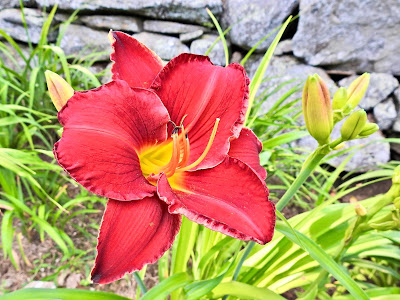7-13-21 VERMONT: It’s been more than a week since the last post, time slips by when you’re busy and, probably, a bit demented. Rain—good amounts almost every day and an inch last night for a total of 1.75 inches for the week. Nobody’s watering here, for now.
With the upper pond down a foot, in spite of all the rain, I decided that it was time to do repairs on the spillway waterfall. The problem was that water ran down through and behind the rocks, causing erosion and, perhaps, threatening the integrity of the the waterfall and dam. I took all the turf off the top to expose the surface and then dug out the dirt to see the structure. There were multiple holes and gaps, it was like a sieve.
I filled all the gaps with gravel, tamped it down, and mixed up a bunch of concrete and filled the holes and added some large rocks to the mix to, hopefully, make the top of the waterfall watertight. When it’s thoroughly dry, another day or so, I’ll replace the turf. We will have to wait for the pond to fill and overflow to assess the job.
Add to the above job a bunch of pruning, mostly apple trees, a bit of weeding, and some new perennials. Judy and I went to Frost Gardens for their perennial sale, they hope to close for the season at the end of July, and are offering nice price reductions. I bought three Ligularia dentata, two ‘Othello’ and one ‘Desdemona’, and four lupin. I planted the Ligularia in the porch bed near the Ligularia there now that has thrived for several years. The lupin will go into a new bed on the bank of the big pond near the primrose bed.
Lupin are legumes, like beans, clover, peas and some other plants, and legumes can take nitrogen directly from the air. The air is 80% nitrogen, and nitrogen is one of the main elements in fertilizer. This ability is called nitrogen fixation, and it means that leguminous plants don’t need fertilizer, in fact they add nitrogen to the soil. The Native Americans knew this and planted beans, legumes, with corn, a heavy feeder.
The heavy, thick turf on the banks of the pond is great growing material, but the grasses there are so embedded that they own the bank. When I try anything new on the bank, I dig out the turf and do the planting with fresh soil in the hole I’ve made so the new, struggling plant won’t have to compete with the established and aggressive grasses. Lupin, being a legume, grows in the poorest soils, and it’s super power is that other plants can’t grow where it can. So, to make the lupin bed, I dug out a large section of the turf, including all the roots.
When the rain stops, I will fill that hole with sand, from the town’s motor yard, it’s free for residents. It will be the poorest of soils. The Lupin will go there and grow and not be overwhelmed by other stuff. That’s the plan.
New blooms: more hybrid daylilies, campanula, bindweed, second meadow rue.
Monarch butterfly on bee balm, hopefully, the bees won't be too offended. Hybrid daylily. These colors are so vivid. Foxglove is another favorite of mine. Filipendula makes this frothy flower that makes me think of opening a bottle of champagne. Last Saturday we went to the Chelsea Flea Market. Chelsea is the seat of Orange County, where we live. it's an old Vermont town with lots of old buildings and two greens, both covered with dealers. Judy bought a silhouette of an English officier from the Revolutionary War. General store on Chelsea's main street. The Orange County Courthouse in Chelsea with its gold dome. On the road back from Chelsea, we stopped briefly at Huntington Farms for a glimpse at the riding competition. A farm on the road. The tractor is haying.









No comments:
Post a Comment